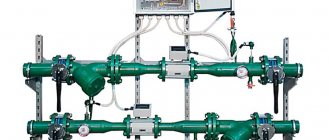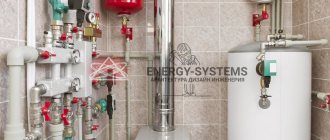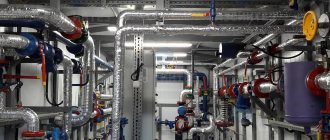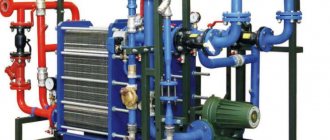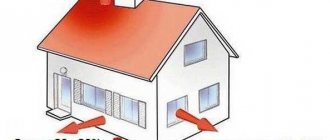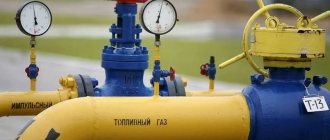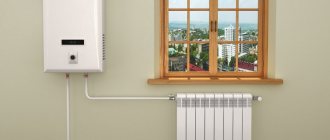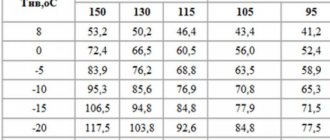Heating standard value and calculations per 1 sq. m
The heating standard depends on the condition and design of the building and the climatic zone.
Heat consumption regulations are calculated in accordance with the conditions for high-quality service provision, which are prescribed in the legislation of the Russian Federation. The norms are changed in accordance with the prescribed legal procedure.
Cases for reform:
- reorganization of technical equipment and design of an apartment building, climate change, in which resource consumption in a residential building changes by 5% or more;
- modification of existing rules regarding the composition of heat consumption standards, methods and conditions for calculating cost indicators and expenses.
The company that supplies heat to the area submits settlement documents to local authorities with a strong justification for the new standards. Authorized services analyze the materials and make additional requests if necessary.
The city council holds a meeting to discuss, accept, or deny the organization's requests for performance improvements. Based on the resolution, a recalculation is made and changed tariffs are introduced for consumers.
The decision of the authorities is published within 10 days in local information media, indicating the date when the new standard for thermal energy consumption comes into force.
How to pay less
Studies have shown that apartments in multi-storey buildings unprepared for the heating season lose almost 40% of the heat generated by radiators of central and autonomous networks. This means that residents pay for heating the atmosphere, but not the apartment.
To reduce resource leakage and heating fees, it is recommended to fulfill the following conditions:
- Install a heat meter, preferably a common one and an individual one. This will allow you to keep control over your consumption.
- Metal-plastic windows retain heat in an apartment more reliably than those with wooden frames. But the first ones need to be looked after and before the start of the heating season, call a specialist for preventive procedures and adjusting the frames. This saves up to 20% money and heat.
- A glazed balcony will also protect against waste of valuable service. A loggia that is tightly closed in winter prevents 10% of the heat from escaping to the street.
- Modern-type radiators contribute to a greater transfer of heat energy to the room than old cast-iron radiators, even with the same utility supply.
- The thermostats installed on new radiators will not allow the apartment owner to heat the non-residential area. By covering a temporarily empty room, you can save some money.
- The biggest losses occur through the walls and ceiling. If you insulate them, then almost half of the heat received will remain in the room. For this purpose, blocks made of mineral wool, expanded polystyrene, and other materials are used.
The last resort is the most expensive, but it will reduce heating bills and improve the quality of heating.
Every resident can calculate the amount of contribution in an apartment or private house. You just need to install collective and individual heat meters. Metering devices will allow you to save the heat energy received and avoid the multiplying factor added in the absence of meters. You should not forget about insulating your home.
Watch the video: “Free heating course.”
Free consultation by phone! Moscow and region: ; St. Petersburg and region:
Comfortable room temperature
Comfortable temperature indicators are regulated by the state. In Russia, standards are prescribed for all regions.
Standards for temperature parameters are contained in the document GOST 30.494 - 2011 and include indicators depending on the type of room:
- in the rooms a comfortable temperature is considered to be +20 - +22°C;
- in the kitchen - +19 - +21°C;
- in the bathroom - +24 - +26°C;
- in the toilet - +19 - +21°С;
- in the hallway - +18 - +20°C.
If the temperature does not reach these values, the heating norm for 1 m2 of the house is not met, you can complain and demand a recalculation of the energy consumed.
The standards take into account the purpose of the premises. The bedroom should be ventilated, after which it should be at a normal temperature. In children, the temperature at the upper limit is considered normal, and as the child grows older, it moves to the lower limit. In the bathroom, the increased rate is due to dampness, which makes you feel dank.
What determines the weather in your home?
Modern equipment allows you to maintain hot water supply standards to heating radiators without much human intervention. But the number on the device is one thing, but the actual heat in the apartment is completely different. The final result depends on many parameters:
- The climate of the area where you live. In Moscow, with its drier climate, the cold is felt less than in St. Petersburg with its dampness.
- Thermal conductivity of the structure. Houses built of brick have lower thermal conductivity than block houses. As a result, the temperature of the water in the heating radiators may be lower due to less heat loss.
- Location of the apartment in the house. Corner rooms freeze more than apartments located in the center of the house. Heat loss in heating radiators will be greater.
- Decoration Materials. Walls covered with heat-saving wallpaper retain heat longer. This reduces heat loss from radiators and central heating radiators.
- Heating radiator material. Cast iron batteries give off less heat than steel ones.
Temperature standards in external networks
All these indicators will affect the atmosphere in the house regardless of the heating temperature standards. It also doesn’t matter how hot the radiators or radiators in the apartment are.
Calculation of payment for heat taking into account standards
The calorie is used in calculating the heat consumption of residential buildings and the multi-apartment sector. One unit is equal to 4.1868 J. This amount is enough to heat one gram of water by 1°C. To get 1 cu. m of hot water with a temperature of +60°C (the lower indicator of the energy carrier in the heating main) requires 60 Mcal. To heat 100 m3 of liquid you need 6 Gcal.
Multi-apartment buildings are considered as indivisible objects that consume energy to heat the premises within them. Rules of standards for heating 1 sq. m provides for the calculation of thermal energy for the entire house throughout the year, on the basis of which an average value is obtained.
An apartment building includes non-residential and residential premises and common areas (basements, attics, staircases) and payment is distributed to the owners of the apartments. The size is determined in proportion to the area of the premises of individual owners.
To take into account the amount of heat that home users were able to consume, citywide heating standards per 1 square meter are used. In 2022, the government established new standards for accounting for heat consumption for heating utility rooms, and the line “general household needs” appeared in the receipt.
Energy
How to calculate energy costs with your own hands, knowing the heat consumption?
It is enough to know the calorific value of the corresponding fuel.
The easiest way is to calculate the energy consumption for heating a house: it is exactly equal to the amount of heat produced by direct heating.
An electric boiler converts all consumed electricity into heat.
Thus, the average power of an electric heating boiler in the last case we considered will be equal to 4.33 kilowatts. If the price of a kilowatt-hour of heat is 3.6 rubles, then we will spend 4.33*3.6=15.6 rubles per hour, 15*6*24=374 rubles per day, and so on.
It is useful for owners of solid fuel boilers to know that firewood consumption rates for heating are about 0.4 kg/kWh. Coal consumption rates for heating are half as much - 0.2 kg/kWh.
Coal has a fairly high calorific value.
Thus, in order to calculate the average hourly consumption of firewood with your own hands at an average heating power of 4.33 kW, it is enough to multiply 4.33 by 0.4: 4.33 * 0.4 = 1.732 kg. The same instructions apply to other coolants - just look in the reference books.
Calculating your heating fee
To save money, consumers install separate meters in their apartments, which allow them to measure the amount of energy consumed without an average calculation according to standards. The devices are installed by specialists and sealed before use.
The number in the payment document depends on the calculation method:
- according to the readings of the apartment meter with the addition of the share of heat energy consumption for heating common areas;
- based on the calculated share for a separate apartment according to the figures from the common building heat meter;
- by calculation using local standards, if there is no general and individual device.
According to the law, the fee is calculated only for the period of actual heating or is spread over the entire year. The option is chosen by the district or city authorities. In the second version, an additional correction factor is applied. In houses with common meters, whose residents pay throughout the year, recalculation is made for the summer months.
With a common house meter
If a high-rise building has a meter, but individual apartments are left without them, Gcal is calculated for heating its own area and the heat costs for heating the common space are added. The values of the device, the area of the house and the square footage of the apartment are taken into account.
The collective meter readings are submitted to the management office, and they are indicated in the next receipt. Information about the general square footage of the house can be found in the housing and communal services in the acceptance documents. The area of the apartment is specified in the technical passport, and tariffs can be found in the heating network.
Consumption is calculated using the formula: P = V x S / S1 x T, where:
- V – amount of energy used according to the control device.
- S – square footage of your own apartment.
- S1 – area of non-residential and residential premises of the building.
- T – legal tariff for heat energy.
The total volume of heat used in the house is divided by square meters of housing. The result is a share for a separate apartment, this value is multiplied by the heating network tariff.
There is no communal appliance, no individual meters
In this case, the current heat consumption standard per 1 sq. m is used. m. The regulated indicator determines the volume of heat to heat a square of housing per month. The climate in the regions of the Russian Federation is different, so local authorities set different quotas in the constituent entities of the Federation. The type of housing and the state of communications in the building matter.
Costs are calculated using the formula: P = S x N x T, where:
- S – area of an apartment or non-residential premises.
- N – consumption rate.
- T – heat tariff.
The area of housing is multiplied by the current norm, and the estimated amount of heat required for heating is determined. Such calculations sometimes do not correspond to actual energy costs. The government obliges residents to install common meters in apartment buildings.
There is a meter and counters
Installing a meter in an apartment allows the owner to pay for the heat actually supplied to the home. The rules provide for mandatory acceptance of readings from individual devices by utility workers if the house has a collective meter and at least 50% of personal premises (by area) are equipped with individual devices.
The fees paid by individual owners are added up. A portion of each is calculated in accordance with instrument readings. The share of consumption among premises equipped with meters is calculated. The resulting value is multiplied by the allocated amount of payment for Gcal for apartments with individual metering and the payment for heat per month is displayed.
The payment amount may be less or more than what has already been paid. This determines whether an additional fee will be charged in the next period or recalculated to a smaller contribution.
Thermal energy for Moscow for 2022
| Single rate tariff. For consumers, in the absence of differentiation of tariffs according to the connection scheme (excluding VAT). RUB/Gcal | |
| from 01/01/2021 to 30/06/2021 | 1776,02 |
| from 07/01/2021 to 12/31/2021 | 1920,87 |
| from 01.01.2022 to 30.06.2022 | 1920,87 |
| from 07/01/2022 to 12/31/2022 | 2077,54 |
| from 01.01.2023 to 30.06.2023 | 2077,54 |
| from 07/01/2023 to 12/31/2023 | 2239,75 |
| Single rate tariff. Population (including VAT). RUB/Gcal | |
| from 01/01/2021 to 30/06/2021 | 2131,22 |
| from 07/01/2021 to 12/31/2021 | 2305,04 |
| from 01.01.2022 to 30.06.2022 | 2305,04 |
| from 07/01/2022 to 12/31/2022 | 2493,05 |
| from 01.01.2023 to 30.06.2023 | 2493,05 |
| from 07/01/2023 to 12/31/2023 | 2687,70 |
- Water disposal for 2022
- Hot water for 2022
- Natural gas for 2022
- Solid fuel for 2022
- Coolant for 2022
- Cold water for 2022
- Electricity for 2022
In small settlements, the standard is not established in all cases. There are two options:
- The houses are connected to water supply pipes. In such a situation, an amount is paid that includes maintenance of communications and the actual costs of residents. This also includes the installation of public speakers.
- Water is obtained from wells or individual wells. A common option that allows you to better control resource consumption.
One of the features is the need to take into account more factors than in city apartments. This is affected by the temperature difference between seasons, optimal angles of inclination and pipe size.
Incorrect calculations negatively affect water heating and pressure in the main line, which may be lower than the standards established by law.
To ensure that the standard does not take away unnecessary funds every month, it is worth thinking about the possibilities of saving water.
An obvious way to save on apartment maintenance is to install a meter. With them, it is enough to take readings a couple of times to see a noticeable difference in payments.
IPU allow:
- control resource consumption;
- avoid adding a multiplying factor;
- stop paying for water supply during absence.
The difference can reach several thousand rubles per month - a significant saving. The main thing is not to miss the deadlines for submitting indicators. If it is abused, the consumption will again be calculated according to the standard, and you will have to spend money on checking the IPU by an expert in order to submit a reconciliation report to the HOA.
Quality and heating of hot water
SanPiN clearly indicates the possible limits that must be observed in water collection areas and which cannot be ignored when using hot water heating. The heat supply system used does not in any way affect the temperature standards.
Main heat losses at home
After all, they are established according to epidemiological safety requirements and are aimed at preventing the incidence and spread of infections. For example, skin, contagious, viral and bacterial. The lower standard for heating is at least +60 °C, the upper standard can reach +75 °C.
Quality control rules and heating standards are recorded in the relevant SanPiN clauses. These rules are mandatory when paying for housing and communal services in the Russian Federation.
According to existing clauses, if water heating does not meet standards, the consumer has the right to demand a payment reduction of 0.1% for every three degrees. If the supplied water temperature is below +40 °C, then it is paid for as cold.
Energy accounting
The consumer has the right to demand quality control even in the case where the water contains foreign impurities of any origin, if their presence is systematic.
The standards and quality requirements for providing the population with hot water have not changed either in 2022 or this year, 2022. However, it is planned that next year, 2022, a two-component tariff for water payments will be introduced everywhere.



